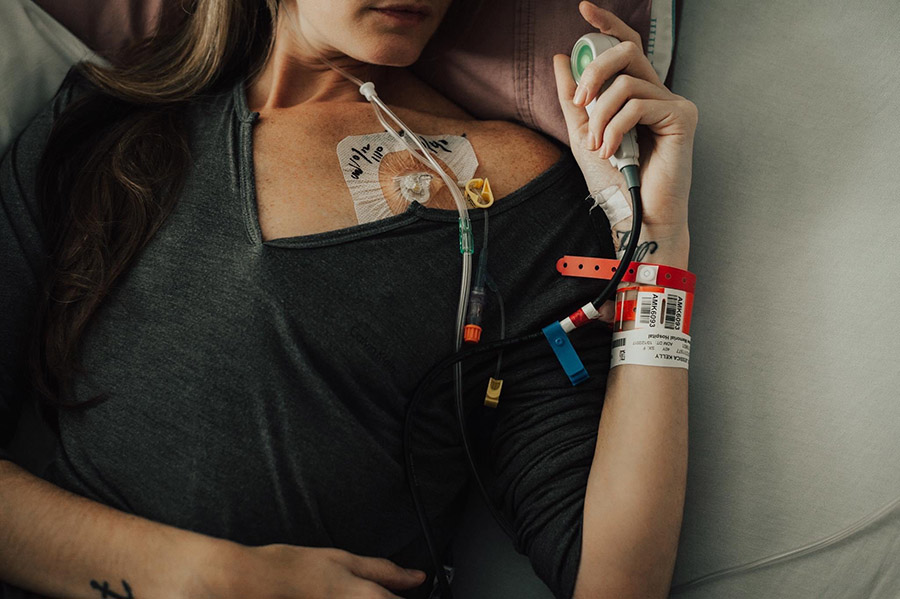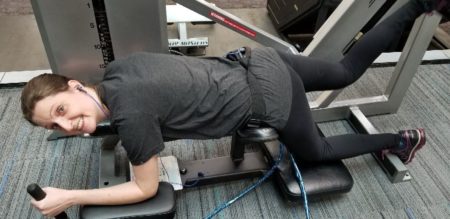Words and Photos by Jessica Miles
Living with a permanent ostomy can bring on significant changes in one’s personal, social and professional life. My biggest fear around having my ostomy surgery was leakage, particularly in public, skin breakdown and altered body image. There was a lot of trial and error in the beginning, but I have found what works for me as well as the confidence to share about it. I have always been an empath and very compassionate, however, I have now found a new passion for helping others (through my surgeon and on social media) learn how to manage their ostomy as well as how to cope with their new life. If you are willing and able to adapt, you can do anything!

In 2016, after years of unexplained symptoms, countless procedures, hospitalizations, tests, and a couple of misdiagnoses, it was confirmed that I had a genetic connective tissue disorder caused by a defect in the protein collagen. I was diagnosed with Classical type Ehlers-Danlos Syndrome. More than 90% of people with Classical EDS have mutations in the COL5A1 or COL5A2 gene. I have a mutation of the COL5A2 gene. The condition is inherited in an autosomal dominant manner. Treatment and management is focused on preventing serious complications and relieving symptoms.
Classical EDS is associated with skin hyperextensibility, joint laxity, fragile blood vessels, joint hypermobility, migraines, joint and muscle pain. Some individuals with this subtype have a deformity of heart valves and may experience a dilatation of the aorta. In cEDS there is also an increased risk for aortic dissection. cEDS patients are prone to hernias and organ prolapse, as well as comorbidities such as autonomic dysfunction…which regulates heart rate, blood pressure, temperature, pupillary response and digestion.
I ended up having multiple surgeries over the past four and a half years due to intestinal dysmotility, prolapses and hernias, resulting in a port and a permanent ostomy. I now, have an ascending end colostomy. While I prepared for years for the possibility of having one, I realized nothing truly prepares you for the actuality of living with a bag on your belly for the rest of your life. Though little by little, the stigma took a back seat to the reality that life with an ostomy can be just as good, if not better for some, than life without one. I suffered constantly from abdominal pain, nausea, vomiting, bloating, constipation, bowel obstructions and malabsorption. While I still struggle with many debilitating symptoms of my disorder, I am now able to eat, gain weight and go to the bathroom regularly. Something I always took for granted until I was no longer able to do so.
My symptoms aren’t usually visible to the untrained eye, but they are life-altering for me.
Though I have a constant physical reminder of my condition in the ostomy, to the rest of the world, mine is a largely invisible illness.
 It’s hard to describe how I feel to someone who has no idea what daily life with a chronic illness is like. I feel awful on the inside but look perfectly fine on the outside. Putting on a brave face for all to see has become a habit. My symptoms aren’t usually visible to the untrained eye, but they are life-altering for me.
It’s hard to describe how I feel to someone who has no idea what daily life with a chronic illness is like. I feel awful on the inside but look perfectly fine on the outside. Putting on a brave face for all to see has become a habit. My symptoms aren’t usually visible to the untrained eye, but they are life-altering for me.
I’ve learned to take everything step by step and day by day. My goal is to break down the stigma of ostomies, and while it’s not always easy, to show that one can still thrive and live a happy life with chronic illness. Due to pain and fatigue, I’ve learned to budget my energy, and while I may function normally one day, I usually need to rest the next. It’s all about finding balance. I am blessed to have an amazing support system in my husband and two boys, the rest of my family and friends.
For me, photography has been a powerful way to document my health journey and what I experience every day. It helps me see my progress, as well as setbacks in a cathartic way.
I am a registered nurse nationally certified in inpatient obstetrics. Unfortunately due to my illness, continuous surgeries and hospitalizations, I made the most difficult decision of my life and gave up the profession I worked so hard for and one that was a huge part of my identity. I am also an award-winning, internationally published photographer, focusing primarily on birth photography and self-portraiture. I found a new purpose, capturing laboring women and their deliveries combined both of my passions: childbirth and photography.

As a photographer, I believe that art enhances the well-being of individuals, society, and our environment and that artists have the power to heal, inspire, provoke, challenge, and offer hope. For me, photography has been a powerful way to document my health journey and what I experience every day. It helps me see my progress, as well as setbacks in a cathartic way. Photography allows people to see different perspectives and can be used as a tool for personal healing and positive change for many while nurturing creativity and self-expression.

My favorite quote is by the artist, Frida Kahlo. “At the end of the day, we can endure much more than we think we can.” I have definitely found this to be true and learned I am much more resilient than I ever thought I was. My illness has caused me to know myself better, which keeps my work honest and true. In the process, you truly meet yourself, which makes for better, more authentic work.





 pantyliners in my underwear. When I retired from active duty in August 1996, I immediately started my second career as an Army JROTC Instructor in Bennettsville SC. I continued to go to the bathroom quite frequently and in the spring of the following year my daughter, who was six at the time, wanted me to play horsey with her and take her around the block. I bent down half in tears and told her that “daddy can’t play horsey because he is too sore on his bottom”. I immediately went to talk to my wife and we both agreed it was time to get back to having an ostomy bag. That summer at the Columbia SC Veterans Administration hospital, I had my third surgery to restore my ostomy due to my poor quality of life with the J Pouch. On the positive side, since I’ve had an external pouch, the veteran’s administration awarded me 100% total and permanent disability. I spent the next 23 years as an Army JROTC Instructor.
pantyliners in my underwear. When I retired from active duty in August 1996, I immediately started my second career as an Army JROTC Instructor in Bennettsville SC. I continued to go to the bathroom quite frequently and in the spring of the following year my daughter, who was six at the time, wanted me to play horsey with her and take her around the block. I bent down half in tears and told her that “daddy can’t play horsey because he is too sore on his bottom”. I immediately went to talk to my wife and we both agreed it was time to get back to having an ostomy bag. That summer at the Columbia SC Veterans Administration hospital, I had my third surgery to restore my ostomy due to my poor quality of life with the J Pouch. On the positive side, since I’ve had an external pouch, the veteran’s administration awarded me 100% total and permanent disability. I spent the next 23 years as an Army JROTC Instructor.





 Because of the trauma I had gone through and my passion to continue training, I was inducted into the U.S. Martial Arts Hall of Fame as 2017’s Woman of the Year. Happy to say I am the first ostomate to ever be inducted. It’s a little weird to say, but I actually inspired myself, knowing everything I had gone through, and that I pushed myself to be my best. So, I continued to push my training to where I was able to train 3-4 hours 5 times a week. In 2018, I was invited to perform for the Abbot and test for my black belt at the Shaolin Temple in Dengfeng, China, which was a tremendous honor.
Because of the trauma I had gone through and my passion to continue training, I was inducted into the U.S. Martial Arts Hall of Fame as 2017’s Woman of the Year. Happy to say I am the first ostomate to ever be inducted. It’s a little weird to say, but I actually inspired myself, knowing everything I had gone through, and that I pushed myself to be my best. So, I continued to push my training to where I was able to train 3-4 hours 5 times a week. In 2018, I was invited to perform for the Abbot and test for my black belt at the Shaolin Temple in Dengfeng, China, which was a tremendous honor. As a person with a complicated medical history, I was definitely paying attention, and started taking precautions very early to mitigate risk. As anyone who lives with a compromised immune system and chronic illness knows, when we get sick, it can have a way of snowballing.
As a person with a complicated medical history, I was definitely paying attention, and started taking precautions very early to mitigate risk. As anyone who lives with a compromised immune system and chronic illness knows, when we get sick, it can have a way of snowballing.


 The seatbelt wrapped around my waist and caused me to lose blood flow to my intestines, which then had to be removed. I was left with no absorptive function and diagnosed with SBS. Though some people may arrive at an SBS diagnosis as a result of other gastrointestinal (GI) conditions, my introduction to SBS was abrupt. One day I was a college basketball player and homecoming king. The next I woke up in the ICU being told I would likely never eat or drink again.
The seatbelt wrapped around my waist and caused me to lose blood flow to my intestines, which then had to be removed. I was left with no absorptive function and diagnosed with SBS. Though some people may arrive at an SBS diagnosis as a result of other gastrointestinal (GI) conditions, my introduction to SBS was abrupt. One day I was a college basketball player and homecoming king. The next I woke up in the ICU being told I would likely never eat or drink again. journey! But despite triumphing over those physical challenges, I had more hurdles to face, particularly in terms of my mental and emotional health.
journey! But despite triumphing over those physical challenges, I had more hurdles to face, particularly in terms of my mental and emotional health.



